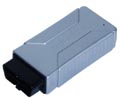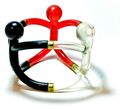- EWS I Components
- |
- Intoduction EWS I
- |
- EWS Systems
- |
- BMW Electronic Systems
- |
- Technical Info
- |
- Car Tech Info
- |
- MicroTronik
EWS I System Components


Starter Immobilization Relay:
The Starter Immobilization Relay was installed on E31, E34 and E36 vehicles.
It was in the following location:
E36 - In the relay carrier to the left of the steering column.
E31/E34 -In the “A” pillar above the footwell kick panel speaker.
The Starter Immobilization Relay functions as a “Smart Relay”, a relay which receives inputs from various sources looking at the proper combination of input signals before activating a component, in this case the starter.
The Starter Immobilization Relay receives input from:
• Ignition Switch
• General Module
• Board Computer
• Trans Range Switch
• DME (>6/94)
And processes output to:
• Starter
• DME
Door Lock Cylinders and Switch:
The door lock cylinders and switch input a High/Low signal into the GM informing the GM of lock status. The signal is high when the system is in Double Lock.
General Module:
The GM receives the High/Low signal from the door lock switch and outputs a High/Low signal to the Starter Immobilization Relay. A High signal indicates the vehicle is in Double Lock.
Board Computer:
The Board Computer outputs a High/Low signal to the Starter Immobilization Relay. A High signal indicates the Code function is active.
Transmission Range Switch:
The Transmission Range Switch input with automatic transmission equipped vehicles allows the Starter Immobilization Relay to provide a Neutral safety switch function. A High signal from the Trans range switch indicates the transmission is in Park or Neutral. A Low signal indicates the transmission is in a drive gear and will prevent starter operation.
DME:
The DME is both an input device (after 6/94) and an output device of the Starter Immobilization Relay.
Input
Starting with production 6/94, the DME “TD” (engine speed) signal was added to the inputs of the Starter Immobilization Relay. This additional input allows the relay to provide a starter protection feature. The internal relay contact (starter operation) opens if the TD signal exceeds 60 Hz which equals the following engine speeds:
• 4 cylinder =1800 RPM
• 6 or 12 cylinder =1200 RPM
• 8 cylinder =900 RPM
The relay contacts will close when the exceeded Hz value drops to 5Hz below the maximum value. This is intended as a safety feature to prevent starter motor activation when the engine is running above these speeds.
Output
The DME receives a High/Low signal from the Starter Immobilization Relay. When the signal is High, the DME does not activate injector or ignition operation.
DWA (E31):
The DWA outputs a High/Low signal to the Starter Immobilization Relay indicating the condition of the alarm system. A high signal indicates the alarm is armed, preventing vehicle starting.
The EWS Starter Immobilization Relay receives it’s inputs from the Ignition switch, GM (or DWA), BC, Trans Range Switch and the DME (after 6/94). The relay will prevent engine starting if:
• The vehicle is locked from the outside. The GM receives the high signal from the door lock switch and sends a high signal to the EWS.
• The BC Code function is set.
• A DWA high signal is received. (E31only)
• A low signal is received from the Trans Range Switch.
• The engine speed signal from the DME exceeds 60Hz. (after 6/94)
The Ignition and injection functions of the DME are disabled and the KL50 start signal to the starter is opened to prevent starter operation.
is one of the best Professional scan tools to for BMW; Autohex allows you to diagnose, code, program/flash ecus, replace with used ECUs, and add new keys for BMW. For more information: BMW Scan Tool
Key learning when all keys lost


